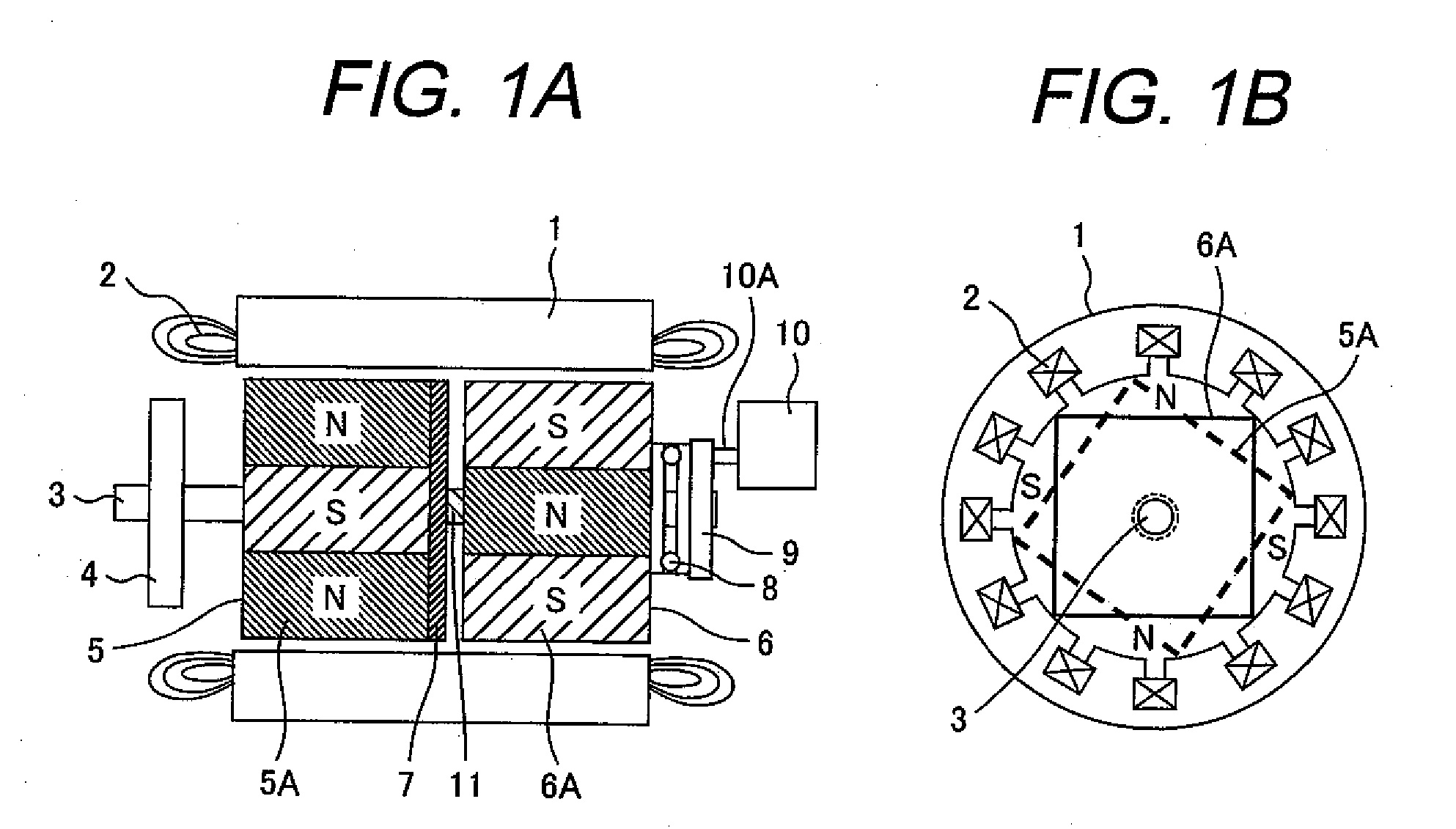Variable magnetic flux electric rotary machine
a magnetic flux and electric rotary machine technology, applied in the direction of motor/generator/converter stopper, dynamo-electric converter control, magnetic circuit shape/form/construction, etc., can solve the problems of loss due to excitation current flow, increase in heat generated in the coil, efficiency deterioration, etc., to achieve wide operation speed range, high efficiency, and improved efficiency
- Summary
- Abstract
- Description
- Claims
- Application Information
AI Technical Summary
Benefits of technology
Problems solved by technology
Method used
Image
Examples
first embodiment
[0032]The first embodiment is described below referring to FIG. 1 and FIG. 2A to FIG. 2C.
[0033]FIG. 1 shows the structure of an electric rotary machine according to the first embodiment. As shown in FIG. 1, a plurality of open-ended slots (also called grooves) are axially continuously formed in the inner surface of a cylindrical stator core 1 in the rotation direction, with an armature winding 2 (also called a stator winding or primary winding) fitted in each of the slots. The outer side of the stator core 1 is fastened to a housing (not shown) by shrink fitting or press fitting and an end thereof in the axial direction is covered by a bracket 4.
[0034]A rotor is rotatably disposed inside the stator core 1 with a gap from it. The rotor is axially divided into two half rotors which are a first rotor 5 fixed on a shaft 3 and a second rotor 6 which can move axially along the shaft while rotating on a spline 11 provided in the shaft 3. The second rotor 6 provides a spline hole engaged wi...
second embodiment
[0048]The second embodiment is described below referring to FIG. 3A to FIG. 3C. In the description below, the same components as used in the first embodiment are designated by the same reference numerals and their description is omitted and only the components different from those in the first embodiment are described.
[0049]This embodiment concerns an electric rotary machine which has a third rotor 12 between the first rotor 5 and second rotor 6, as illustrated in FIGS. 3A to 3C. In this electric rotary machine, the second rotor 6 and third rotor 12 are activated depending on torque and revolution speed, as shown in FIG. 3A to 3C. More specifically, in this embodiment, there are three stages in which the second rotor 6 and third rotor 12 move axially on the spline 11 as shown in FIG. 3A to FIG. 3C.
[0050]In the stage of FIG. 3A, in which the effective flux should be maximized, the first rotor 5, third rotor 12 and second rotor 6 are brought closer and united and the permanent magnets...
third embodiment
[0062]The third embodiment concerns an improvement in the mechanism for rotation of the second and third rotors relative to the first rotor in the second embodiment. In the description below, the same components as used in the foregoing embodiments are designated by the same reference numerals and their description is omitted and only the components different from those in the foregoing embodiments are described.
[0063]As shown in FIG. 7, the third embodiment uses a flux varying mechanism which includes an interlock means 19 and grooves 20 both located in the third rotor 12 to activate the second rotor and third rotor according to the second embodiment. This mechanism is so designed that by applying a force to one movable wedge 21 laterally, an interlock holder 23 with springs 22 moves the other movable wedge similarly.
[0064]How the second rotor 6 and third rotor 13 are activated is described below referring to FIGS. 8A to 8F. As shown in FIGS. 8A to 8C, projections 24 of the second ...
PUM
 Login to View More
Login to View More Abstract
Description
Claims
Application Information
 Login to View More
Login to View More - R&D
- Intellectual Property
- Life Sciences
- Materials
- Tech Scout
- Unparalleled Data Quality
- Higher Quality Content
- 60% Fewer Hallucinations
Browse by: Latest US Patents, China's latest patents, Technical Efficacy Thesaurus, Application Domain, Technology Topic, Popular Technical Reports.
© 2025 PatSnap. All rights reserved.Legal|Privacy policy|Modern Slavery Act Transparency Statement|Sitemap|About US| Contact US: help@patsnap.com



